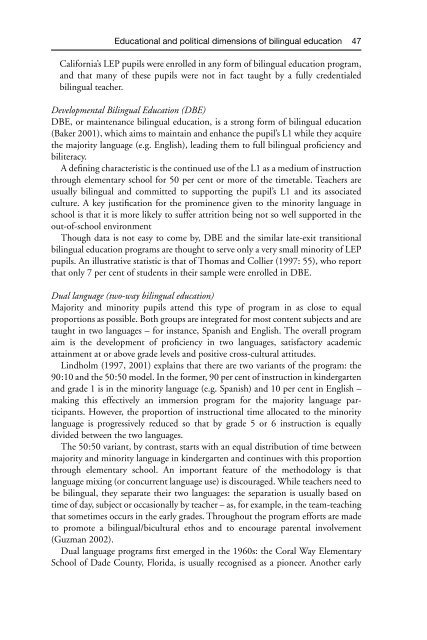Gibson Ferguson Language Planning and Education Edinburgh ...
Gibson Ferguson Language Planning and Education Edinburgh ...
Gibson Ferguson Language Planning and Education Edinburgh ...
You also want an ePaper? Increase the reach of your titles
YUMPU automatically turns print PDFs into web optimized ePapers that Google loves.
<strong>Education</strong>al <strong>and</strong> political dimensions of bilingual education 47<br />
California’s LEP pupils were enrolled in any form of bilingual education program,<br />
<strong>and</strong> that many of these pupils were not in fact taught by a fully credentialed<br />
bilingual teacher.<br />
Developmental Bilingual <strong>Education</strong> (DBE)<br />
DBE, or maintenance bilingual education, is a strong form of bilingual education<br />
(Baker 2001), which aims to maintain <strong>and</strong> enhance the pupil’s L1 while they acquire<br />
the majority language (e.g. English), leading them to full bilingual proficiency <strong>and</strong><br />
biliteracy.<br />
A defining characteristic is the continued use of the L1 as a medium of instruction<br />
through elementary school for 50 per cent or more of the timetable. Teachers are<br />
usually bilingual <strong>and</strong> committed to supporting the pupil’s L1 <strong>and</strong> its associated<br />
culture. A key justification for the prominence given to the minority language in<br />
school is that it is more likely to suffer attrition being not so well supported in the<br />
out-of-school environment<br />
Though data is not easy to come by, DBE <strong>and</strong> the similar late-exit transitional<br />
bilingual education programs are thought to serve only a very small minority of LEP<br />
pupils. An illustrative statistic is that of Thomas <strong>and</strong> Collier (1997: 55), who report<br />
that only 7 per cent of students in their sample were enrolled in DBE.<br />
Dual language (two-way bilingual education)<br />
Majority <strong>and</strong> minority pupils attend this type of program in as close to equal<br />
proportions as possible. Both groups are integrated for most content subjects <strong>and</strong> are<br />
taught in two languages – for instance, Spanish <strong>and</strong> English. The overall program<br />
aim is the development of proficiency in two languages, satisfactory academic<br />
attainment at or above grade levels <strong>and</strong> positive cross-cultural attitudes.<br />
Lindholm (1997, 2001) explains that there are two variants of the program: the<br />
90:10 <strong>and</strong> the 50:50 model. In the former, 90 per cent of instruction in kindergarten<br />
<strong>and</strong> grade 1 is in the minority language (e.g. Spanish) <strong>and</strong> 10 per cent in English –<br />
making this effectively an immersion program for the majority language participants.<br />
However, the proportion of instructional time allocated to the minority<br />
language is progressively reduced so that by grade 5 or 6 instruction is equally<br />
divided between the two languages.<br />
The 50:50 variant, by contrast, starts with an equal distribution of time between<br />
majority <strong>and</strong> minority language in kindergarten <strong>and</strong> continues with this proportion<br />
through elementary school. An important feature of the methodology is that<br />
language mixing (or concurrent language use) is discouraged. While teachers need to<br />
be bilingual, they separate their two languages: the separation is usually based on<br />
time of day, subject or occasionally by teacher – as, for example, in the team-teaching<br />
that sometimes occurs in the early grades. Throughout the program efforts are made<br />
to promote a bilingual/bicultural ethos <strong>and</strong> to encourage parental involvement<br />
(Guzman 2002).<br />
Dual language programs first emerged in the 1960s: the Coral Way Elementary<br />
School of Dade County, Florida, is usually recognised as a pioneer. Another early






